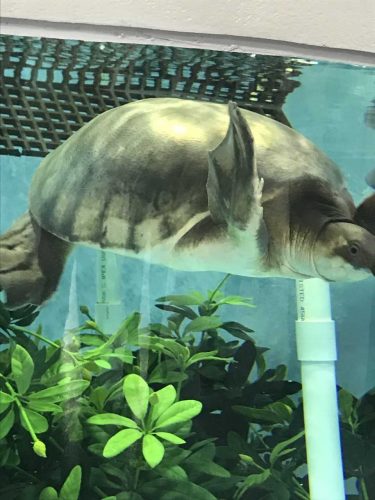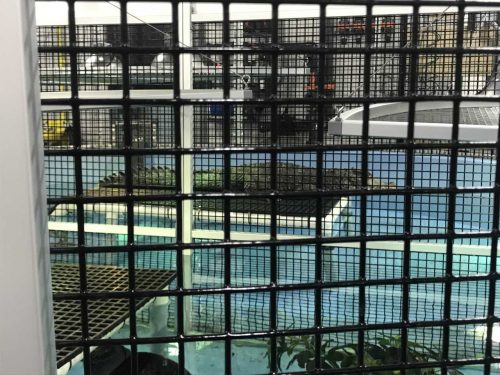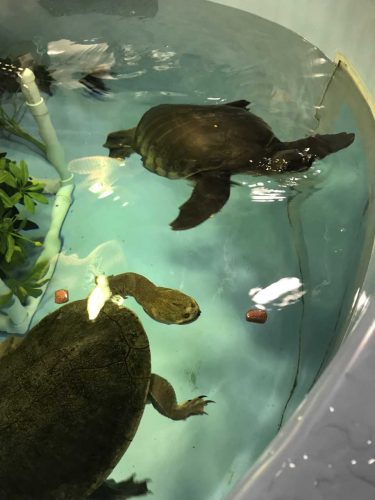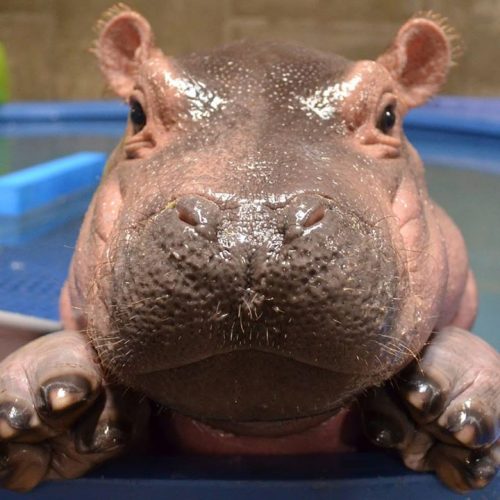Journey to the National Aquarium

Animal Care and Research Center
Blog post by JMM intern Alexia M. Orengo Green. To read more posts from JMM interns, past and present, click here.
As an intern in the Jewish Museum of Maryland, I have been to various field trips to several museums in the Baltimore and Washington DC area. On these field trips I have been able to learn various aspects about the museum filed and everything that entitles working in them. From all the field trips that we went to this summer, my favorite one has been the visit to the National Aquarium Animal Care and Research Center. I know, you must be wondering, what does a Care and Research Center have to do with museums? In reality it has to do a LOT.

The National Aquarium Animal Care and Research Center officially opened its doors on May 2018. The building contains the National Aquarium’s exhibit fabrication space, water production equipment, and doubles the capacity to care for rescued animal. From the moment we arrived at the Center we were told that this Rehabilitation Center was different from the rest. In contrast with other Centers, which the public has either limited or no access to it, the building was design to have visitors. The National Aquarium wanted people to feel welcomed to a space where they can learn about a lot of aspects from the Aquarium that often go behind the scenes.
The sense of welcomeness to the public can be felt from the moment one steps through the front door. The space has an open feel and invites the curiosity of the visitor. In the lobby of the Center one of the first things one notices is the large vitrine that allows visitors to see into the production area. The production area has various functions, which include creating and fixing exhibits, producing new features for the exhibits, and creating toys for the different animals they have in the Aquarium and the Center. To be able to make the exhibits for the animals the manufacturers must do intensive research to recreate the environments of the ocean with materials that are durable. The toys the manufacturers create also require research and are made to challenge the animal. An example we were giving during our visit was a crab that was being created for an octopus. The octopus was going to have to open the crab to “hunt” for his food. Once the octopus has master how to open the crab, the mechanics would be changed to continue challenging him.

Meanwhile, on the other side of the lobby its the classroom where visiting groups receive information about the work that is happening in the Center. There they are given an introduction and talked about the different journeys of the animal that they have in the Center. To do this, the care takers recreate the process in which the animals arrive to the center and what happens to them once they are there. Each person is given a card with the information and name of one of the animals on the Center, and they are responsible for the care of that animal. While the groups are being toured around the building, they learn about the proper care of the animals they were assigned require. They are also given the opportunity to “recreate” one of the procedures that vets do to make sure the animals that just arrived are healthy. Through “recreating” the procedure the visitors can see that no animal is small enough for veterinarian attention.

One of the main parts of the tour of the Center are the exhibits. Each panel was thoughtfully created to explain the different types of works that are done in the center. All the panels were made in the production side of the Center and can be easily adapted depending on the information that is displaced. An example of one of the ways in which they were able to make the panels adaptable is the one regarding the care of the seals. The panel has pictures of the seals that have been on the Center that can be easily changed if a new seal arrives. They also have clipboards containing the information of each seal. The panels also have a bag that contains interactive objects to facilitate the learning experience for visitors. The bag of the seals’ panel has an example of what they would use to rehydrate seals when they arrive to the center.
For our tour we were able to see the lab and kitchen where the care takers make the food for each animal in the center. But for me, the must exciting part of the tour was seeing the animals that were on rehabilitation. The center has two caimans, fishes, and turtles! As a big turtle fan, you can say I was extremely happy when I saw them. The care takers talked about their diet and care while they are in the center. They also talked about how each animal has its own personality and their individual journey. It was incredible to see these animals receiving the care they need and establishing a connection with them when visiting the center.

The connection that one stablishes with the animals that are on the Center makes the visitor more compelled to learn about the different ecosystems and animals. But the Center is not the only place that has been able to create that experience for their visitors. The Cincinnati Zoo has been able to establish a strong connection between its visitors and their baby hippo Fiona. Through social media the zoo has been able to share moments from Fiona’s life that otherwise would not be available for the public. I, for example, have never been to Cincinnati but I would love to go just to see Fiona. Ever since I first heard about Fiona, I have learned several hippo facts that I didn’t know before. The effect that the Cincinnati Zoo has achieved with their hippo Fiona is one that the National Aquarium Care and Research Center can achieve through its tours.

Even though the Care and Research center is not a typical museum in contains many aspects that normal museums have. The architecture and design of the building was created for receiving visitors, which is one of the reasons why the building feels inviting. The production area gives the visitors the chance to see a behind the scenes look into how the exhibits of the aquarium are created and how thorough the process is. The building is created to teach its visitors about the ocean wild life, how is being affected today, and what they can do to help it.
Many thanks to Adam Nelson, Jessica Young, and Candice Canady for facilitating our special tour of the center!
